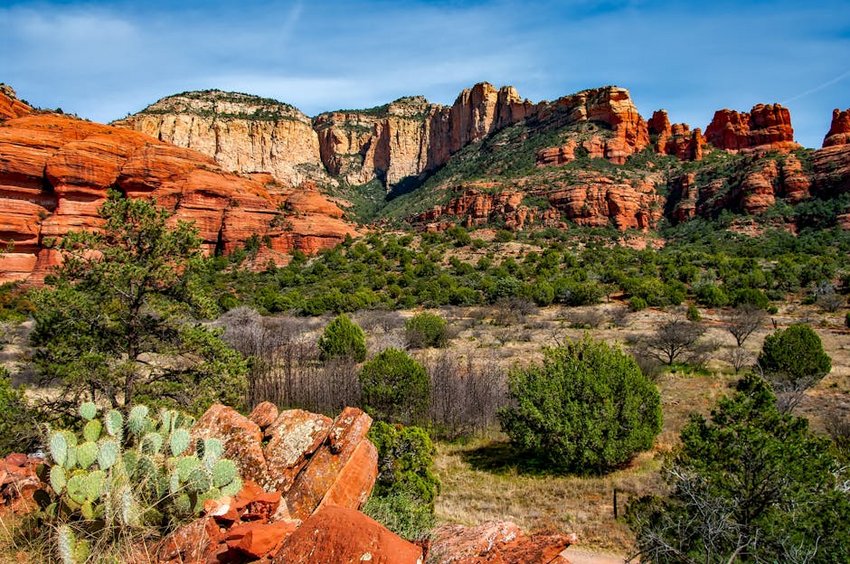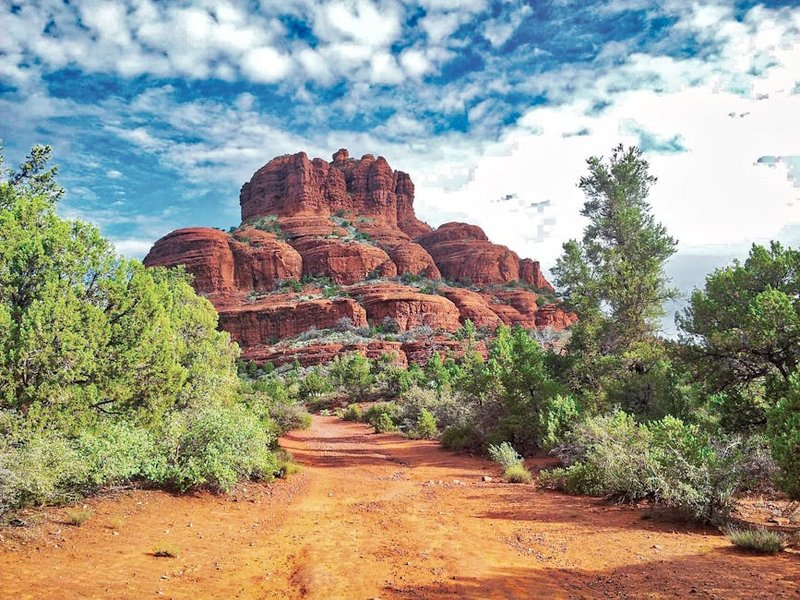Arizona Sedona Red Rock Trails
Exploring the Arizona Sedona Red Rock Trails is like stepping into a living painting where nature’s artistry unfolds with every step you take. These iconic trails wind through stunning red rock formations, offering breathtaking vistas that captivate hikers, photographers, and nature lovers alike. Located in the heart of Arizona’s high desert, Sedona’s trails provide a unique blend of adventure and tranquility, with routes suitable for all experience levels. You’ll discover why this destination is a bucket-list item for many travelers, thanks to its vibrant landscapes, spiritual energy, and diverse outdoor activities. Whether you’re seeking a challenging hike or a peaceful stroll, the Arizona Sedona Red Rock Trails deliver an unforgettable experience that connects you deeply with the natural world. From the famous Cathedral Rock to the serene Oak Creek Canyon, each trail tells a story of geological wonder and cultural significance, making it a must-visit for anyone craving outdoor exploration in the American Southwest.
Arizona Sedona Red Rock Trails Essential Information
Understanding the basics of the Arizona Sedona Red Rock Trails will help you plan a seamless and enjoyable trip. Sedona sits at an elevation of about 4,500 feet, which means you’ll experience mild temperatures but should prepare for potential altitude effects if you’re not accustomed to higher elevations. The trails are managed by various entities, including the Coconino National Forest and Red Rock State Park, so it’s essential to check for any permits or fees required. You’ll find that the red rocks are composed of sandstone and limestone, formed over millions of years, creating the dramatic hoodoos, spires, and mesas that define the landscape. Additionally, Sedona is renowned for its vortex sites, which are believed to emit spiritual energy, adding a unique dimension to your hiking experience. When you visit, remember that the area is a fragile ecosystem, so practicing Leave No Trace principles is crucial to preserve its beauty for future generations.
What You Need to Know About the Trails
- Trail difficulty varies widely, from easy paths like the Bell Rock Pathway to strenuous climbs such as Bear Mountain, so choose routes that match your fitness level and experience.
- Weather can change rapidly, with summer temperatures soaring above 100°F (38°C) and winter bringing occasional snow, so always check forecasts and pack accordingly.
- Many trails are dog-friendly but require leashes, and some areas have limited shade, so bring plenty of water and sun protection for you and your pets.
- Budget options include camping in national forest sites for $15-30 per night, packing your own meals, and using free trails like Fay Canyon, keeping daily expenses under $50 per person.
- Mid-range choices involve staying in Sedona motels or vacation rentals for $100-200 nightly, dining at casual restaurants, and adding guided hikes or jeep tours costing $50-150 per activity.
- Luxury experiences feature upscale resorts like Enchantment Resort starting at $300+ per night, fine dining, and private tours, with daily budgets easily exceeding $300 per person for a premium adventure.
- Official Sedona Tourism
- Coconino National Forest
Key Geological Features
The geological history of Sedona’s red rocks is a fascinating tale of ancient seas, wind, and water erosion that sculpted the landscape over eons. You’ll encounter iconic formations like Cathedral Rock, which rises sharply from the desert floor and is a popular spot for sunrise hikes, offering panoramic views that are worth the early wake-up call. Another highlight is Bell Rock, known for its distinctive bell shape and accessible trails that let you get up close to the vibrant iron oxide-rich sandstone. As you explore, you’ll notice the layers of rock tell a story of different eras, with the Schnebly Hill Formation showcasing colorful bands of red, orange, and white. These features aren’t just visually stunning; they also provide habitat for diverse wildlife, including mule deer, javelinas, and a variety of bird species, making your hike a chance to connect with nature on multiple levels.

Arizona Sedona Red Rock Trails Planning Your Trip
Planning your visit to the Arizona Sedona Red Rock Trails involves considering factors like seasonality, budget, and personal preferences to ensure a rewarding adventure. Sedona attracts over three million visitors annually, so timing your trip to avoid peak crowds can enhance your experience, especially on popular trails like Devil’s Bridge or Soldier Pass. You’ll want to allocate at least three to five days to fully immerse yourself in the area, allowing time for hiking, exploring nearby attractions, and relaxing in the town’s charming boutiques and galleries. Budget-wise, Sedona offers options for every traveler, from affordable campgrounds to luxury resorts, but keep in mind that parking fees, shuttle services, and guided tours can add up. By researching in advance and booking accommodations early, especially during festivals or holidays, you’ll secure the best deals and avoid last-minute stress. Don’t forget to factor in travel insurance, as unexpected weather or health issues could disrupt your plans, and having coverage provides peace of mind for your Southwestern journey.
Best Time to Visit Sedona Red Rock Trails
The ideal time to hike the Arizona Sedona Red Rock Trails is during the spring (March to May) or fall (September to November), when temperatures range from 60°F to 80°F (15°C to 27°C), providing comfortable conditions for outdoor activities. In spring, you’ll enjoy wildflower blooms and flowing creeks, while fall offers stunning foliage and clear skies, perfect for photography. Summer can be extremely hot, with highs often exceeding 100°F (38°C), so if you visit then, plan early morning or late evening hikes and carry extra water to avoid heat exhaustion. Winter brings cooler weather, with daytime temperatures in the 50s°F (10-15°C) and occasional snow dusting the red rocks, creating a magical but slippery landscape; traction devices for shoes are advisable. Regardless of season, afternoons may bring sudden thunderstorms in monsoon season (July-August), so always check local forecasts and be prepared to adjust your plans for safety.
Budget Planning and Costs
Essential Preparation Checklist
Preparing for the Arizona Sedona Red Rock Trails requires attention to detail to ensure a safe and enjoyable trip. Start by researching trail conditions and closures on official websites like the Coconino National Forest page, as weather or maintenance can affect access. Pack essential gear such as sturdy hiking boots with ankle support, a backpack with at least 2 liters of water per person, high-energy snacks, a first-aid kit, and navigation tools like a map or GPS device, since cell service can be spotty. Dress in layers to adapt to temperature changes, and include sun protection like hats, sunglasses, and sunscreen, as the desert sun is intense even on cooler days. If you’re driving, ensure your vehicle is suitable for rough roads if you plan to explore areas like Schnebly Hill Road, and consider renting a high-clearance vehicle for off-road adventures. Finally, familiarize yourself with local regulations, including parking permits or shuttle requirements, to avoid fines and make the most of your time on the trails.
Arizona Sedona Red Rock Trails Top Attractions and Activities
Sedona’s red rock trails offer a wealth of attractions and activities that cater to diverse interests, from adrenaline-pumping adventures to serene nature experiences. You’ll find that each trail has its own character, with some leading to panoramic overlooks and others winding through lush canyons alongside flowing creeks. Beyond hiking, you can engage in mountain biking on designated routes, rock climbing on permitted formations, or even joining yoga sessions at vortex sites for a spiritual recharge. The area is also rich in cultural history, with ancient Native American ruins and art galleries in town that showcase local craftsmanship. For a unique perspective, consider hot air balloon rides at sunrise or stargazing tours at night, where the clear desert skies reveal a dazzling canopy of stars. No matter your preference, the Arizona Sedona Red Rock Trails provide endless opportunities to create lasting memories in one of America’s most scenic landscapes.
Must-See Highlights
Cathedral Rock Trail is a must-do for its challenging ascent and rewarding views, especially at sunset when the rocks glow in vibrant hues; the 1.2-mile round trip involves some scrambling but offers iconic photo opportunities. Devil’s Bridge, another popular spot, features the largest natural sandstone arch in the Sedona area, accessible via a moderate 4.2-mile hike that culminates in a thrilling walk across the bridge for brave visitors. For a easier option, the Bell Rock Pathway provides a flat, 3.6-mile loop with stunning vistas and vortex energy, ideal for families or those seeking a leisurely stroll. Don’t miss Oak Creek Canyon, often called a smaller cousin of the Grand Canyon, where you can swim in cool waters or picnic amid towering cliffs. These highlights represent the essence of Sedona’s beauty, combining physical activity with awe-inspiring scenery that will leave you feeling connected to the natural world.
Hidden Gems and Local Favorites
Venture off the beaten path to discover hidden gems like the Birthing Cave, a less-crowded trail that leads to a scenic cave formation with spiritual significance, offering a peaceful retreat from busier areas. The Secret Slickrock Trail is another local favorite, featuring slickrock formations and solitude, perfect for meditation or quiet reflection amidst the red rocks. For a unique experience, explore the Honanki Heritage Site, where you can view well-preserved cliff dwellings and rock art from the Sinagua people, providing a glimpse into ancient cultures. If you’re up for a drive, the nearby ghost town of Jerome adds historical intrigue, with its mining history and eclectic shops just a short trip from Sedona. These lesser-known spots allow you to escape the crowds and immerse yourself in the authentic charm of the Arizona desert, making your visit truly special.
Arizona Sedona Red Rock Trails Practical Travel Information
Navigating the practical aspects of your trip to the Arizona Sedona Red Rock Trails will ensure a smooth and stress-free adventure. Sedona is approximately a 2-hour drive from Phoenix Sky Harbor International Airport, making it easily accessible for domestic and international travelers, with rental cars being the most convenient option for flexibility. Once in town, you’ll find that parking at popular trailheads can be limited, especially on weekends, so using the Sedona Shuttle service during peak times is a smart choice to avoid congestion. Accommodations range from budget-friendly chain hotels to boutique inns and luxury resorts, with many offering stunning red rock views and amenities like spas or pools. When it comes to dining, Sedona boasts a vibrant food scene with Southwestern cuisine, farm-to-table restaurants, and casual cafes, but reservations are recommended for dinner to secure a spot. Overall, planning ahead for transportation, lodging, and meals will help you focus on enjoying the breathtaking landscapes and outdoor activities that define this iconic destination.
| Category | Options/Features | Price Range (USD) |
|---|---|---|
| Accommodation | Campgrounds, motels, vacation rentals, luxury resorts with spas and views | $15-50 (camping), $80-200 (mid-range), $250-500+ (luxury) |
| Transportation | Rental cars, shuttles, guided tours, bike rentals | $30-100 daily (car rental), $5-15 (shuttle), $50-150 (tours) |
| Activities | Hiking, jeep tours, hot air balloons, cultural sites | Free (hiking), $50-200 (tours), $150-300 (balloon rides) |


